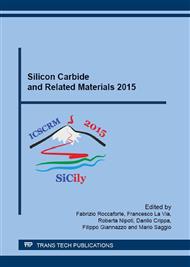p.167
p.173
p.177
p.181
p.185
p.189
p.193
p.197
p.201
Effects of Sulfur Passivation on 6H-SiC(0001) Surface and Si/6H-SiC Interface
Abstract:
The un-passivated and passivated 6H-SiC(0001) surface and Si(-220)/6H–SiC (0001) interface are investigated by first-principles calculation based on density functional theory. It is demonstrated that the surface energy of 6H-SiC(0001) surface with seven atom-layers converges well. When the surface is passivated with sulfur(S), the density of states decreases obviously, implying that the passivated 6H-SiC(0001) surface are more stable. Four specific geometry models of Si(-220)/6H–SiC(0001) interface structures with different terminations are chosen. The calculated adhesion energies suggest that, for un-passivated interface, the atomic binding force and interface stability of C-termination interface are stronger than Si-termination interface, while for passivated interface, the tendency is opposite. The calculations about the density of states of un-passivated interfacial suggest that the Si-Si covalent bonds are formed at Si-terminated interface, and that C-Si covalent bonds are formed at C-terminated interface. After the interface is passivated with S atoms, the interaction between Si and S atoms is observed.
Info:
Periodical:
Pages:
185-188
Citation:
Online since:
May 2016
Authors:
Price:
Сopyright:
© 2016 Trans Tech Publications Ltd. All Rights Reserved
Share:
Citation:


